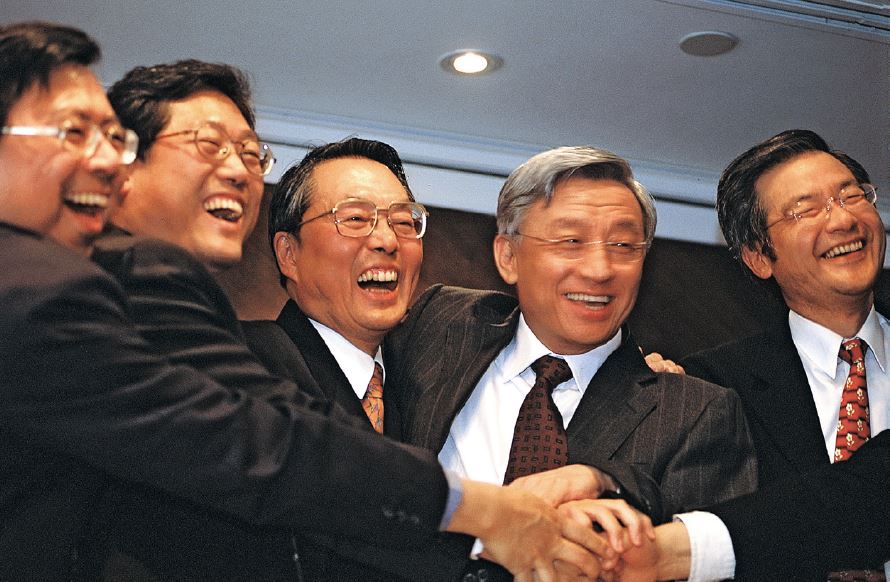Taiwanese Tech's Hunt for a New Front
Why Are the Big Bosses Feuding?

Source:CW
Taiwan's tech sector has recently been roiled with strife. Terry Gou and Barry Lam, Bob Tsao and K.Y. Lee... sworn partners have become completely estranged. Behind the discord lies a high-tech mid-life crisis.
Views
Why Are the Big Bosses Feuding?
By Benjamin ChiangFrom CommonWealth Magazine (vol. 434 )
"It was the best of times and the worst of times," Dickens wrote in the opening line of A Tale of Two Cities, a line that may well be equally applicable to the current situation in Taiwan's technology sector.
The global financial crisis has accelerated the pace of the vertical integration of Taiwan's tech sector and has ushered in a completely new operating model.
Over the past year, acrimony has spread across the tech sector, with the titans of the industry grumbling and grousing amongst one another. The once close cooperation between Quanta Computer and Foxconn Electronics has evaporated with Foxconn's entry into the low-cost notebook computer business, and the erstwhile good friends have in an instant turned on one another.
Similarly, AU Optronics Corp. and United Microelectronics Corp., once cordial neighbors on Hsinchu Science Park's Lixing Second Road with friendly relations between their respective bosses, K.Y. Lee and Bob Tsao, have in a flash gone from comrades to competitors with AU's announcement of its entry into the LED business.
Taiwan Tech Sector's Mid-life Crisis
There are no eternal friends in the marketplace, only enduring interests. Behind the acrimony among tech sector bosses "lies a tech sector mid-life crisis that can't be concealed, as yesterday's growth models have hit a bottleneck," observes T.C. Tu, deputy director of the Commerce Development Research Institute, adding that companies are now facing a crucial moment of massive changes in their operating models.
Taiwan is the world leader in 15 IT products, including notebook computers and motherboards, "but these have a gross profit margin of only three to four percent," says Chu Po-young, a professor with National Chiao Tung University's Department of Management Science. Taiwan's OEM-centric tech sector is like a little dinosaur whose hunger cannot be assuaged, ever reliant on massive orders of low-margin goods to drive revenue growth while neglecting organic growth, he contends.
Traditional Taiwanese technology businesses are only focusing on improving the hardware, moving from desktop PC and notebook computers to the development of netbooks.
But there are now huge changes in applications," says Quanta Computer chairman Barry Lam. Taiwan is forever viewing things from a technological perspective, but seldom considers things from a market or applications angle, Lam adds.
However, now with the business environment rapidly changing, and European and American consumer markets still sluggish amidst an ongoing recession, they find themselves in the embarrassing position of being unable to come up with new products.
"The dinosaur is unable to locate its original sustenance (orders) and must now evolve into a more fiercely adaptable mammal," Lam says.
Vertical Integration Beats Horizontal Acquisition
Vertical integration of the production chain has always been the model for the technology industry to lower costs and raise competitiveness.
"Mature industries definitely have to move toward vertical integration," says Kirk Yang, former managing director and head of Asia tech research at Citigroup. "This is the only way to push cost down as low as possible. If you don't integrate, you'll be integrated."
With Foxconn's entry into the notebook computer and LCD TV businesses, other notebook makers responded by forming "anti-Foxconn alliances." Quanta, Compal, Wistron and Inventec are all tacitly accelerating upstream acquisitions of component companies such as case makers to increase their ratio of in-house manufacture.
"In the past, most Taiwanese companies have tended toward horizontal competition, but with increasing cost pressures they are moving toward vertical integration," Topology Research Institute chairman Chen Ching-wen says. "Waters that initially did not mix are now of the same vessel."
As the scale of operations of technology companies grows ever bigger, their business operations are becoming ever more alike. "They're all moving toward developing the ‘Three Screens' (television screens, computer screens and cell phone screens), in an effort to seek outlets other than the computer business."
According to Chiu Yi-chia, an associate professor with National Chung Hsing University's Department of Business Administration, business management can be divided into three axes: the product axis, the customer and geographical region axis, and the vertical chain axis.
When a company pursues growth, growth of the customer and product axes is relatively easy to achieve. Taiwan's technology entrepreneurs are being forced to develop the integration of their vertical chains, but establishing a vertical chain is fraught with difficulties.
"Changing the deployment of a vertical chain represents huge changes in the operational model and products, tantamount to entering entirely new product categories," Chiu says.
The global financial crisis has prompted companies to reconsider the necessity of vertical integration.
Previously, vertical integration was all about cutting costs. "Now, business groups are beginning to slash upstream and downstream elements of the chain, demanding that all enterprises in the group be profitable," says Compal Communications president Steven Chen.
Increasing vertical integration can in fact quickly alleviate the urgency of cost-cutting measures for companies. "However, upstream and downstream integration increases the probability of scattering the focused usage of corporate resources," T.C. Tu says, casting doubt on the efficacy of vertical integration. Companies in the end must focus on increasing value without staking everything on cost.
The next wave of competition will not simply be in the organization of vertical integration, but in the battle to find the best way to coordinate the three axes of customers, products and the vertical chain. All the big bosses will be ruminating on how to create a breakthrough operating model.
Translated from the Chinese by Brian Kennedy







